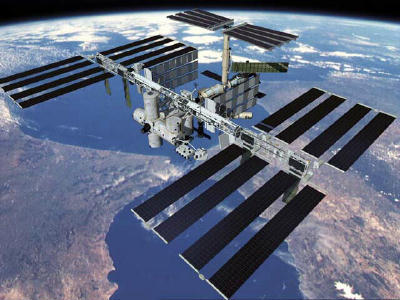By MARCIA DUNN, AP Aerospace Writer Marcia Dunn, Ap Aerospace Writer – Thu Nov 20, 4:59 pm ET
CAPE CANAVERAL, Fla. – NASA couldn't have staged (安排) it any better: 10 people in orbit for Thursday's 10th anniversary of the world's most elaborate and expensive housing project, the international space station.  On Nov. 20, 1998, the first part of the space station was launched by the Russians from Kazakhstan. NASA followed up two weeks later with piece No. 2 carried up by a space shuttle(航天飞机). Astronauts and cosmonauts (女宇航员) moved in two years later, and the rest, as they say, is history.
On Nov. 20, 1998, the first part of the space station was launched by the Russians from Kazakhstan. NASA followed up two weeks later with piece No. 2 carried up by a space shuttle(航天飞机). Astronauts and cosmonauts (女宇航员) moved in two years later, and the rest, as they say, is history.
The space station has grown into a behemoth (庞然大物) outpost (偏远的定居点) 220 miles up, home to three people at any given time — soon to be six.
Thanks to the newly arrived shuttle Endeavour, the space station now has five sleep stations, two baths, two kitchens and two mini-gyms. All told, there are nine rooms, three of them full-scale labs.
Three-quarters complete, the total mass is 627,000 pounds. NASA says it's about the size of a five-bedroom house.
Some other fascinating factoids*[note]: The space station has traveled 1.3 billion miles, orbited Earth more than 57,300 times, hosted 167 people from 15 countries, and served up more than 19,000 meals.
The space station has taken longer for NASA and its international partners to build, cost more money and produced less science than originally envisioned(想象,预想). But that hasn't spoiled the celebrations going on all over the world — and off.
For the record, the linked Endeavour and space station sailed past the 10-year mark at 1:40 a.m. EST Thursday while the astronauts slept. Mission Control marked the occasion by showing video of the first rocket's launch in 1998.
"After 10 years, we wish the international space station a happy birthday and we hope to see many, many more," Endeavour commander Christopher Ferguson said in a taped message from the orbiting complex (合成体:由相互关联交织的部分组成的整体).
Later Thursday, flight controllers around the world exchanged wishes of "Happy Birthday!" and "Happy Anniversary!" with the station's skipper(船长), Mike Fincke.
Before rocketing away aboard Endeavour last Friday, astronaut Donald Pettit noted that every major engineering marvel has had its share of dragged-out (drag out 拖延) schedules, budget overruns (泛滥成灾,超出限度), controversy, even scandal.
"How long did it take us to build the Panama Canal, Brooklyn Bridge?" Pettit said.
As for the space station, "We're 10 years down the road, and it still isn't built. It's almost built. And it's an amazing, wonderful piece of technology that once it's done, people probably won't even think too much about how long it took to build," said Pettit, who called the complex home for five months in 2002-2003.
To date, it's taken 80 rocket launchings from Florida, Kazakhstan and French Guyana (the launching site for the European Space Agency's cargo carrier) to make and staff the space station.
The price tag, from start to finish, is often quoted at $100 billion. That includes money spent not only by the United States and Russia, but also Canada, Japan and the 18-nation European Space Agency. NASA disputes that amount and estimates its share at $44 billion, including shuttle launch costs.
As for delays, the 2003 Columbia disaster set space station construction back by a few years. So did Russian financial problems in the 1990s that significantly delayed the launch of the first crew's living quarters.
Its objective also has shifted over the years. NASA views the space station as essentially a place to learn more about astronaut health and other issues that could make or break future expeditions (考察,远征) to the moon, Mars and beyond. Before, the emphasis was supposed to be on basic scientific experiments, like protein crystals and cell tissue.
Managers like to point out that the technical problems that have cropped up in orbit over the years — a torn solar wing and jammed solar wing-rotating joint to name a few — are lessons learned for deep-space travel.
The Russians, meanwhile, have used the space station as a cash cow (cash cow: 财源,摇钱树), selling rocket rides to the occasional millionaire tourist to help keep their program going.
NASA expects to wrap up (wrap up: 结束,完成) space station construction in 2010 when the three remaining space shuttles are retired. Astronauts then will have to hitch rides on Russian spacecraft (太空船) until NASA's new rocketship (火箭宇宙飞船) is available to crews, most likely in 2015. That gap is an unavoidable thorn (刺, 荆棘)in NASA's side; it's possible the projected five-year hiatus (break) in human launchings from U.S. soil could be whittled (削弱,削减) a little.
NASA Administrator Michael Griffin, who expects to be replaced in the Obama administration, has said repeatedly that the space agency does not have the money to keep flying the shuttles beyond 2010 if it wants to keep its new rocketship and moon exploration plans on track (keep sth. on track 使……正常运转).
"The moon is not the end goal, just like the space station is not the end goal," Griffin noted. "The moon is a stepping stone on the way out."
___
On the Net:
NASA: http://www.nasa.gov/mission_pages/station/main/index.html
factoid: unverified or inaccurate information that is presented in the press as factual, often as part of a publicity effort, and that is then accepted as true because of constant repetition:
被描述为事实的东西:未证实的或不正确的信息作为事实印刷出来,常用作宣传,并且由于不断重复而被接受为事实
本期太空探索相关词汇:
NASA: National Aeronautics and Space Administration (美国)国家航空和宇宙航行局
orbit 轨道; 进入轨道,沿轨道飞行,
space station
launch
space shuttle 航天飞机
astronaut
cosmonaut 女宇航员
rocket 火箭
skipper(船长)
expeditions (考察,远征) to the moon
spacecraft 太空船
rocketship 火箭宇宙飞船

